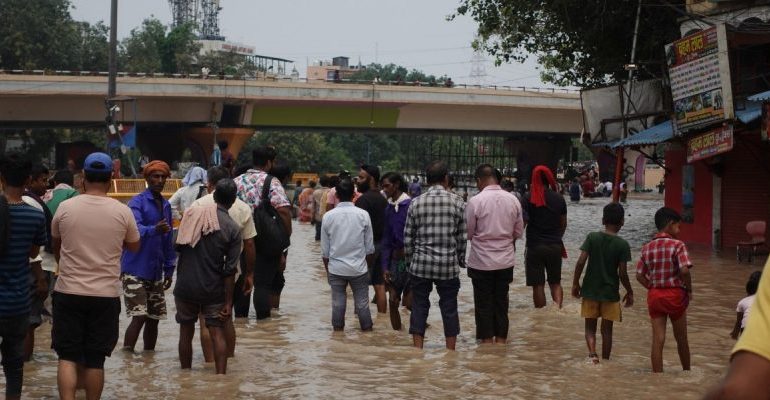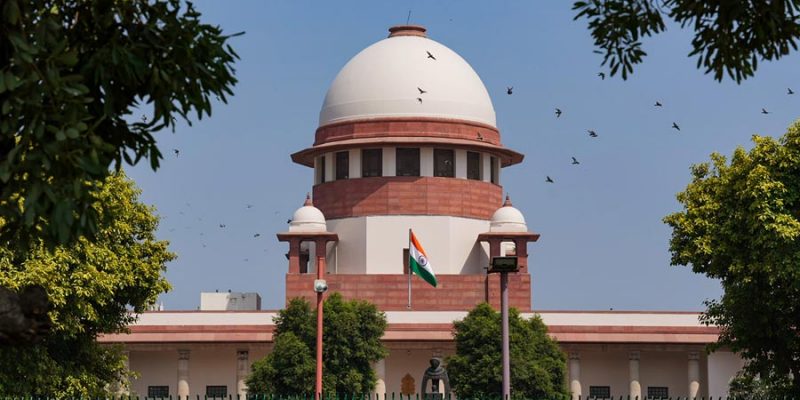Yamuna Continues to Rise Beyond Record High, Delhi Secretariat Housing Offices Flooded

New Delhi: The Yamuna continued to swell beyond its record high on Thursday. By 8 am, it rose to 208.48 meters at the Old Railway Bridge station. Water levels will continue to rise as per the Central Water Commission, which called it an “extreme situation”, reported PTI. The water levels in the Yamuna had already breached its record high of 207.49 (set in 1978) on Wednesday, July 12.
On Thursday morning, the Delhi Secretariat housing offices of chief minister Arvind Kejriwal, his cabinet and other senior bureaucrats was also flooded. As per reports, more than 16,000 people have been evacuated from low-lying areas in the city.
Water levels in the Yamuna could continue to rise, with no let up predicted in the rains upstream. As per the India Meteorological Department’s latest statement on the afternoon of July 13, extremely heavy to heavy rains in Uttarakhand will continue for five days. Rains continue in the northeast: Mawsynram in Meghalaya recorded a whopping 54 cm of rainfall in 24 hours, as per the IMD’s latest observed rainfall data.

The Yamuna flooding in east Delhi. Photo: Shekhar Tiwari
Yamuna continues to rise
The water level at the Old Railway Bridge station crossed the 208-meter mark on Wednesday night and rose to 208.48 meters by 8 am on Thursday, reported PTI. As per the report, the Central Water Commission said that it expected the levels to rise further, and called it an “extreme situation”. Previous reports had said that as per the CWC, the water levels are expected to decrease at 2 pm today.
The water level in the Yamuna crossed the warning water level mark of 204.5 meters in Delhi on July 10. It crossed its highest ever water level – 207.49 meters – which it set in 1978, on Wednesday, July 12.
Extremely heavy rainfall upstream of the Yamuna – in Uttarakhand and its adjoining areas in Uttar Pradesh – over the past few days has resulted in high water levels in the Yamuna downstream. Water continues to be released from the Hathnikund Barrage in Haryana. However, the release of water from the barrage has decreased. According to The Hindu, Delhi government data showed that water released from the Hathnikund Barrage came down from 3.59 lakh cusecs at 11 am on Tuesday to 1.47 lakh cusecs at 8 pm on Wednesday. But the water has a travel time of 36-72 hours to reach Delhi, the news report quoted an official as saying. Hence it would take time for this to reflect in Delhi’s water levels, the official said.
Rains to continue upstream
A let up in the rains in the hills seems unlikely for now.
The IMD has issued a red alert for the state for July 13 and 14.
#RedAlert: #Uttarakhand is under a red alert as heavy to very heavy rainfall (more than 204.4 mm) during 13th to 14th July, 2023.
Stay safe! #RainfallAlert #Monsoon #Monsoon2023 #Uttarakhandrain #uttarakhandweather@moesgoi@DDNewslive@airnewsalerts@ndmaindia@mcdehradun pic.twitter.com/fiZN29NET4
— India Meteorological Department (@Indiametdept) July 13, 2023
In its latest statement in the afternoon of July 13, the IMD has said that Uttarakhand will witness very heavy to extremely heavy rainfall for the next five days. It also predicts that very heavy to extremely heavy rainfall activity will likely continue over north Bihar today, and over Uttar Pradesh, West Madhya Pradesh, northeast India and Sikkim till July 14.
The IMD’s observed rainfall data for 24 hours (till 8:30 am on July 13) show that Mawsynram in Meghalaya recorded a whopping 54 cm of rainfall during this time. Jalpaiguri in northern West Bengal recorded 29 cm of rainfall and north Sikkim, 25 cm. Haridwar district in Uttarakhand continued to witness heavy showers, with Laksar recording 22 cm and Roorkee 19 cm.
The IMD’s statement on July 12 had said that heavy to very heavy rainfall activity is likely to continue over Uttarakhand, Uttar Pradesh and West Madhya Pradesh July 13 and 14 and decrease thereafter.
With no let up in the rains upstream of Delhi, the water levels in the Yamuna may continue to be a concern at the national capital as the river’s catchment areas include parts of Uttarakhand and Uttar Pradesh which are still facing heavy showers.

Temporary shelter for evacuees on Mayur Vihar’s Pusta Road, East Delhi. Photo: Shekhar Tiwari
Flooding in low-lying areas; water supply in some areas to be hit
With the Yamuna in spate, some of Delhi’s water treatment plants have shut down and this could affect water supply to some parts of the city. Delhi chief minister Arvind Kejriwal said on Thursday that water supply may be affected in parts of the city with the shutting down of treatment plants at Wazirabad, Chandrawal and Okhla. Kejriwal also requested people to not use the roads near the river due to the rising water levels. Evacuations are on and people should cooperate with the authorities for the process, he requested.
On Thursday morning, the Delhi Secretariat housing offices of Kejriwal, his cabinet and other senior bureaucrats, was flooded, reported PTI.
Several parts of the city on the banks of the river – such as Monastery Market, Yamuna Bazar, Geeta Ghat and the stretch from Majnu Ka Tilla to Wazirabad – were already flooded on Wednesday, per news reports. As of Wednesday night, more than 16,000 people were evacuated from low-lying areas.
On July 12, Delhi Police had imposed Section 144 under the Code of Criminal Procedure which prohibits the gathering of four or more people, in parts of the city that are prone to floods.







